G.I. Gary Classic Toy Review: Transformers G1 Starscream and the Seekers

In 1984, Hasbro’s “The Transformers” launched, with not only a toyline, but TV show and comic books provided by Sunbow and Marvel. Among the initial release were three transforming robots that turned into F15 fighting jets, Starscream, Skywarp, and Thundercracker. Using the molds from Japanese company Takara’s Diaclone line, these three are the definition of “repaints.” This means they are essentially the same toy, but by using different color plastics and slightly different sticker sheets, you magically have a new toy. They all have the same accessories. The following year they released Thrust, Dirge, and Ramjet. While essentially repaints, they got different wing arrangements so they are more unique, but the basic toy construction, and transformation, is the same. The group had been informally known as “The Seekers” for years, but during the DreamWave comic run, the first official use of the name occured.
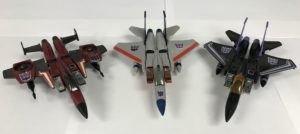 From L to R: Thrust, Starscream, Skywarp (I’d have more but these guys aren’t cheap!)
From L to R: Thrust, Starscream, Skywarp (I’d have more but these guys aren’t cheap!)
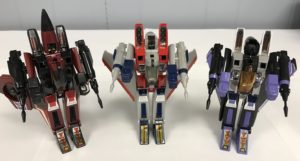 Note the “conehead” on Thrust. The 1985 seekers are known for leaving the nosecone in the up position to distinguish themselves from the earlier guys.
Note the “conehead” on Thrust. The 1985 seekers are known for leaving the nosecone in the up position to distinguish themselves from the earlier guys.
For the rest of the review we’ll be looking at Starscream. He is the leader, and thus should be setting the example after all.
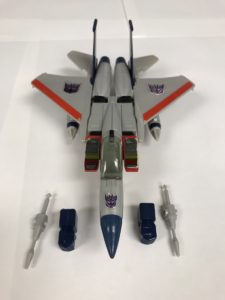
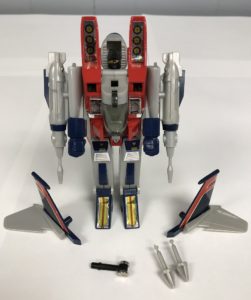
First thing you notice is all those extra parts. Part of the transforming process is to remove or add parts; a trait shared by many of the original Transformers. This makes a huge difference in pricing. Collectors should decide if they just want to buy complete examples, or buy partially complete and hunt the parts down. Also, it helps to have a way to store those extra parts when displaying, er, I mean playing!
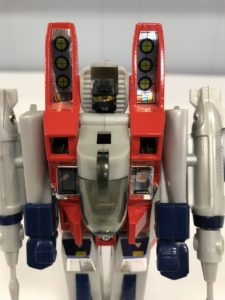
Lets look at his robot mode. Here’s a good close up of the upper torso. The hinge right below the head is commonly found loose after years of play. Even in an otherwise tight toy, it can still be the loosest joint. It took a light touch to keep Starscream’s cockpit chest down as it doesn’t latch or click into place for these pictures. It relies on a friction fit of the pin. The metal pin is pressed in the red metal frame and doesn’t come loose. However, with the soft plastic pivoting on the metal pin, the plastic is going to wear and come apart. Also, look at the gold leaf sticker for his eyes. This area is very small and almost laughable that a child had to put a sticker across for this section. The original owner did a decent job on this.
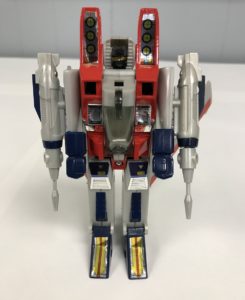
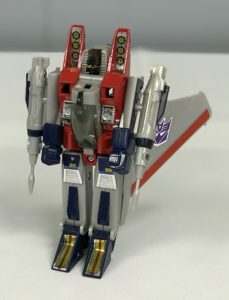
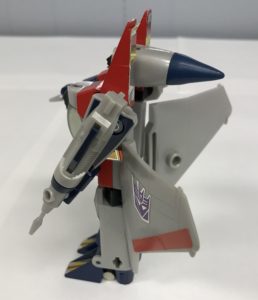
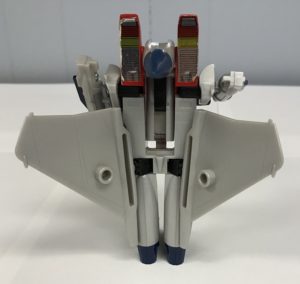
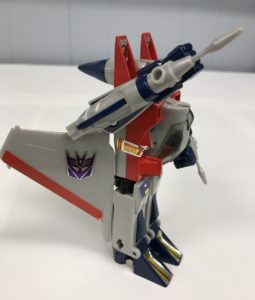
In this group of photos you can see a better overall view of Starscream in his robot mode. The stickers are starting to show their age as they are becoming fragile. Another common flaw is the legs tapering together in the rear view. They are suppose to remain straight, but notice the wings’ hinges. They are another friction fit, but because they are pressed in, they push the legs together. Some light force can straighten them out and then when he rests, they remain straight (look at the front view for an example). The missile launchers gets relocated to the arm from the wing during transformation to robot mode and are spring loaded. These can be fickle, even when new, as the spring inside can get out of position, or even a hanging sprue on the tail of the missile can prevent them from flying out. As a robot “action figure” he has only 2 points of articulation, his left and right arms, which limits him here. He can point at things, and then blast them with the missile launchers (if they work).
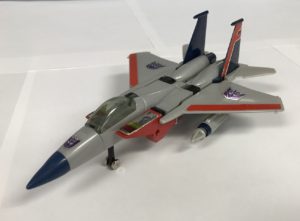
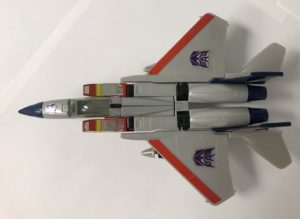
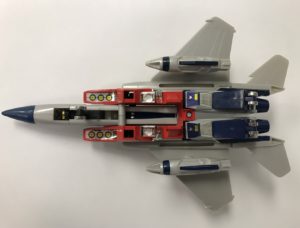
Now lets look at Starscream as a jet. In a top view or 3/4 view he’s pretty impressive. Nice detailing for the scale. The legs are still tapering together, but it seems less pronounced visually, in this “alt” mode. However, if you look at him from the bottom, you can see the remainder of his robot form. This isn’t a jet you would hang from the ceiling, or spend much time looking at the underbelly. Transforming him is rather simple and easy to figure out even without the instructions.
Overall, the Starscream toy is positively influenced by the memories of his appearances in the cartoons and comics. Marvel and Sunbow took some liberties in cleaning up the robot form which translated well for kids playing with the toys. It’s how I remember this character. On the flip side, this toy was designed in about 1982, then released in the US twice; first in 1984, and then in the early 90s as part of the Transformers Generation 2 line; about a 20 year lifespan. You can definitely conclude that this was ahead of its time, as Takara & Hasbro didn’t start pushing the Transformers envelope until the Beast Wars line in the very late 90s.
I give this toy an A- grade. Starscream is pretty much a must have for any Transformers collector, and most toy collectors, he just hits the right notes. It gets this grade partly for its significance to the toyline, and because of his central place in the Transformers mythos. Is he the best transforming jet? No, 1985’s Jetfire is even more impressive, and we’re not even scratching the surface of the “Masterpiece” editions that have only been around about 10 years now. But again, his significance to American toys is such that he deserves a place.
Until next time!



©2018 Pint O’ Comics | About Us | Contact Us | Site created by One Flight Up Design